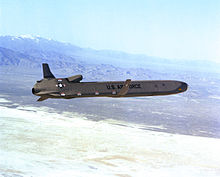
Back إيه جي إم-86 Arabic AGM-86 ALCM Catalan AGM-86 Czech AGM-86 ALCM German AGM-86 ALCM Spanish ایجیام-۸۶ Persian AGM-86 ALCM Finnish AGM-86 ALCM French AGM-86 ALCM HE AGM-86 ALCM ID
This article includes a list of general references, but it lacks sufficient corresponding inline citations. (June 2021) |
| AGM-86 | |
|---|---|
 An AGM-86C in flight | |
| Type | Air-to-ground strategic cruise missile |
| Place of origin | United States |
| Service history | |
| In service | AGM-86B: 1982–present AGM-86C/D: retired |
| Used by | United States Air Force |
| Production history | |
| Designed | 1974 |
| Manufacturer | Boeing Integrated Defense Systems |
| Unit cost | $1 million (AGM-86B) additional $160,000 conversion cost for AGM-86C; additional $896,000 conversion cost for AGM-86D[1] |
| Produced | 1980 |
| No. built | 1,715 (AGM-86B), 239 (AGM-86C), 50 (AGM-86D)[1] |
| Variants | AGM-86B (1982), AGM-86C (1991), AGM-86D (2001) |
| Specifications | |
| Mass | 3,150 pounds (1,430 kg) |
| Length | 20 ft. 9 in. (6.3 m) |
| Diameter | 24.5 inches (620 mm)[1] |
| Wingspan | 12 feet (3.7 m) |
| Warhead | W80 thermonuclear weapon (AGM-86B), 5 or 200 kilotons[2] Conventional warhead (AGM-86C) AUP warhead (AGM-86D) |
| Warhead weight | 908kg (AGM-86C Block 0) 1362kg (AGM-86C Block 1) 1,200 lb (540 kg) class advanced unitary penetrating warhead (AGM-86D)[1] |
| Engine | Williams International F107-WR-101 turbofan engine 600 lbf (2.7 kN) thrust |
Operational range | AGM-86B: 1,500+ mi (2,400+ km) AGM-86C: classified (nominal 680 miles, 1,100 km) |
| Maximum speed | AGM-86B: 550 mph (890 km/h, Mach 0.73) AGM 86C: classified (nominal high subsonic) |
Guidance system | AGM-86B: Litton inertial navigation system element with TERCOM updates AGM 86C: Litton INS element integrated with multi-channel onboard GPS |
Launch platform | Boeing B-52H Stratofortress[1] |
The AGM-86 ALCM is an American subsonic air-launched cruise missile (ALCM) built by Boeing and operated by the United States Air Force. This missile was developed to increase the effectiveness and survivability of the Boeing B-52H Stratofortress strategic bomber, allowing the aircraft to deliver its payload from a great distance. The missile dilutes an enemy's forces ability to respond and complicates air defense of its territory.[3]
The concept started as a long-range drone aircraft that would act as a decoy, distracting Soviet air defenses from the bombers. As new lightweight nuclear weapons emerged in the 1960s, the design was modified with the intent of attacking missile and radar sites at the end of its flight. Further development extended its range so much that it emerged as a weapon allowing the B-52s to launch their attacks while still well outside Soviet airspace, saturating their defenses with hundreds of tiny, low-flying targets that were extremely difficult to see on radar.
Entering service in 1982 as part of the renewed American arms buildup during the Late Cold War, the ALCM so improved the capabilities of the US bomber force that the Soviets developed new technologies to counter the weapon. Among these were airborne early warning aircraft and new weapons like the MiG-31 and Tor missile system specifically to shoot down the AGM-86.[4] The Air Force responded with the development of the AGM-129 ACM, which included stealth capabilities. The ending of the Cold War led to cutbacks in this program, and its expensive maintenance eventually resulted in it being abandoned in favor of life extensions to the original ALCM.
Examples of the AGM-86A and AGM-86B are on display at the Steven F. Udvar-Hazy Center of the National Air and Space Museum, near Washington, D.C.[5]
- ^ a b c d e "Factsheets: AGM-86B/C/D Missiles." Archived 1 August 2013 at the Wayback Machine U.S. Air Force. United States Air Force, 2010. Web. Accessed 14 Dec 2012. "Factsheet". Archived from the original on 21 May 2013. Retrieved 2012-12-14.
{{cite web}}: CS1 maint: bot: original URL status unknown (link) - ^ https://nuke.fas.org/cochran/nuc_84000001c_01.pdf
- ^ "Factsheet: AGM-86B/C/D MISSILES". United States Air Force. Archived from the original on 10 July 2008. Retrieved 7 October 2008.
- ^ "ЗЕНИТНЫЙ РАКЕТНЫЙ КОМПЛЕКС 9К330 "ТОР" (SA-15 Gauntlet)". Вестника ПВО (in Russian). 21 August 2007. Archived from the original on 17 August 2008. Retrieved 9 August 2008.
- ^ "Missile, Cruise, Air-launched, AGM-86B". Collections Database. Smithsonian Institution. Archived from the original on 23 July 2009. Retrieved 7 October 2008.